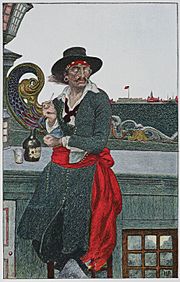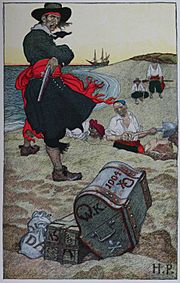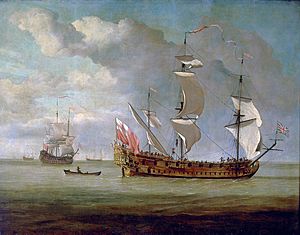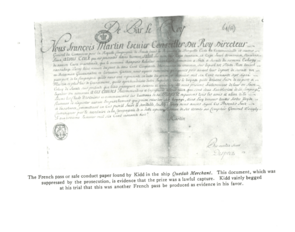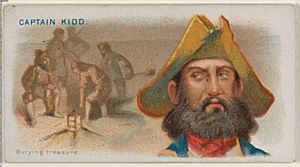William Kidd facts for kids
Quick facts for kids
William Kidd
|
|
|---|---|

Portrait by James Thornhill
|
|
| Born | c. 1645 Dundee, Scotland
|
| Died | 23 May 1701 (aged 56) Wapping, England
|
| Cause of death | Execution by hanging |
| Nationality | Scottish |
| Relatives | Shea Dauphinée, Michael Dauphinée, James Dauphinée |
| Piratical career | |
| Type | Pirate / Privateer |
| Allegiance | Kingdom of England, Province of New York |
| Commands | Blessed William Adventure Galley |
William Kidd, often called Captain Kidd (born around 1645 – died May 23, 1701), was a Scottish sea captain. He started his career as a privateer, which was like a government-approved pirate. Later, he was accused of being a pirate himself. In 1701, he was tried and executed in London for murder and piracy.
Kidd had captured a French ship. He was allowed to do this by the English government as a privateer. However, the political situation in England changed, and he was seen as a pirate. Some historians believe he was unfairly called a pirate and was just doing his job as a privateer. Documents found later supported his side of the story.
Contents
Who Was Captain Kidd?
Early Life and Adventures
William Kidd was born in Dundee, Scotland, before October 15, 1654. He himself said he was from Dundee. Records also show his baptism there. His family even received financial help after his father passed away.
As a young man, Kidd moved to New York City. This city was then controlled by the English. He became friends with many important people, including three governors. Some stories say he worked on a pirate ship before he became a famous privateer.
By 1689, Kidd was part of a French-English pirate crew in the Caribbean Sea. During one trip, Kidd and others took control of the ship from their captain. They sailed to the British colony of Nevis. There, they renamed the ship Blessed William, and Kidd became its captain.
Kidd was an experienced leader. His ship, the Blessed William, joined a small fleet to defend Nevis from the French. The governor didn't pay the sailors. Instead, he told them to take their pay from the French. Kidd and his men attacked the French island of Marie-Galante. They destroyed its town and took about 2,000 pounds sterling.
Later, Kidd captured an enemy privateer off the New England coast. He was rewarded for his success. But then, a famous pirate named Robert Culliford stole Kidd's ship while he was in Antigua.
In New York City, Kidd helped pay for the building of Trinity Church, New York. In 1691, Kidd married Sarah Bradley Cox Oort. She was one of the richest women in New York.
Getting Ready for a Big Trip
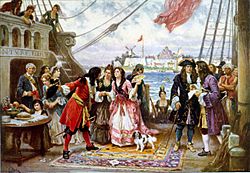
In 1695, Richard Coote, 1st Earl of Bellomont, who governed New York, asked Captain Kidd for help. He wanted Kidd to attack other pirates and French ships. This request came from the King himself. Kidd would have been seen as disloyal if he refused. This trip is what made Kidd famous as a pirate in history.
Wealthy lords in England helped pay for Kidd's journey. King William III of England personally signed a special paper for Kidd. This paper allowed Kidd to be a privateer. It also said that 10% of any treasure found would go to the King. Kidd and his friend Robert Livingston planned the whole trip.
Kidd's new ship was called Adventure Galley. It was perfect for catching pirates. It weighed over 284 tons and had 34 cannons. It also had oars, which was a big advantage. This meant it could move even when there was no wind. Kidd chose his crew carefully, picking only the best sailors.
However, a Navy ship forced many of Kidd's crew to join the Royal Navy. This was not supposed to happen to privateer crews. Short on men, Kidd sailed to New York City. He captured a French ship on the way, which was legal. In New York, he hired new crew members. Many of them were known criminals, some even former pirates.
One of Kidd's officers was Hendrick van der Heul. He was the quartermaster, like a second-in-command on pirate ships. Van der Heul was described as a "small black Man." If he was of African descent, he would be one of the highest-ranking Black privateers known. He was never found guilty of piracy.
Searching for Pirates
In September 1696, Kidd sailed towards the Cape of Good Hope in Africa. A third of his crew died from sickness. His ship also started leaking. He couldn't find the pirates he expected near Madagascar.
Kidd was desperate to make up for his costs. But he didn't attack several ships he could have, because they were not allowed by his orders. Some of his crew left him. Those who stayed often threatened to take over the ship.
Accused of Piracy
Kidd was called a pirate early in his journey. This happened after he refused to let a Royal Navy officer take his crew. Kidd sailed away to protect his men.
On January 30, 1698, Kidd captured his biggest prize. It was the 400-ton Quedagh Merchant. This Indian ship was full of valuable goods like silks, gold, and silver. The captain of the Quedagh Merchant was English, but he had French passes. These passes were supposed to protect his ship.
When news of this capture reached England, officials called Kidd a pirate. Naval commanders were ordered to find and arrest him for "notorious piracies."
Kidd kept the French passes from the Quedagh Merchant. He hoped they would prove he was acting legally. He renamed the ship Adventure Prize and sailed to Madagascar.
In Madagascar, Kidd met Robert Culliford, the same pirate who had stolen Kidd's ship years before. There are different stories about what happened next. One story says Kidd was friendly with Culliford. Another says Kidd wanted to attack Culliford, but his own crew refused.
Most of Kidd's men left him to join Culliford. Only 13 stayed with Kidd. Kidd decided to go home. He left the Adventure Galley behind because it was old and leaky. He burned it after taking off all useful metal parts. He sailed back to the Caribbean on the Adventure Prize.
A special pardon was offered to pirates in the Indian Ocean in 1698. But Kidd was specifically excluded from this pardon. He learned he was wanted as a pirate when he reached Anguilla.
Trial and What Happened Next
Before returning to New York City, Kidd knew he was wanted. He hid the Adventure Prize in the Caribbean Sea. He sold his stolen goods and continued towards New York on a smaller boat. He buried some treasure on Gardiners Island. He hoped this treasure would help him bargain for his freedom.
New York Governor Bellomont was also an investor in Kidd's trip. He was worried about being linked to piracy. He tricked Kidd into coming to Boston with false promises. Kidd was arrested on July 6, 1699. He was put in Stone Prison and kept alone. His wife, Sarah, was also arrested.
Kidd's time in prison was very hard. It was said to have made him unwell. Governor Bellomont turned against Kidd and other pirates.
The government in England changed. The new leaders hoped to use Kidd to make the people who supported him look bad. But Kidd refused to name names. He believed his powerful friends would help him. Since he wasn't politically useful, Kidd was sent to London for trial. He was charged with piracy and the murder of William Moore. He was held in Newgate Prison.
Kidd had lawyers to help him. He was surprised to learn he was charged with murder. He was found guilty of all charges. He was sentenced to death. He was hanged in public on May 23, 1701, at Execution Dock, in London.
Some of Kidd's friends were also found guilty of piracy. But they were pardoned just before they were to be hanged.
Kidd's supporters were embarrassed by his trial. They didn't help him. The two sets of French passes he had kept were missing during his trial. These passes were found much later, in the early 1900s. They confirmed Kidd's story and made people question how guilty he really was.
A song called "Captain Kidd's Farewell to the Seas" was printed after his execution. It made people believe that Kidd had confessed to his crimes.
Captain Kidd's Treasure Legends
Many people believe Captain Kidd left behind buried treasure. This idea helped his legend grow. The song "Captain Kid's Farewell to the Seas" mentions "Two hundred bars of gold, and rix dollars manifold."
This belief has led to many treasure hunts. People have searched on Oak Island in Nova Scotia, Gardiner's Island in New York, Charles Island in Connecticut, and other places.
Captain Kidd did bury a small amount of treasure on Gardiners Island. Governor Bellomont reportedly found it and sent it to England to be used as evidence against Kidd.
A story says that Kidd visited Block Island. He gave Mrs. Mercy Raymond gold and jewels in her apron as payment for her kindness. Her family was later said to be "enriched by the apron."
In 1983, two men searched for Kidd's treasure off Phú Quốc island in Vietnam. They were caught and imprisoned for illegally landing there.
Finding the Quedagh Merchant
For many years, people searched for the Quedagh Merchant. In 2007, it was reported that the shipwreck was found. Divers found it in shallow waters off the Dominican Republic. It was less than ten feet deep and only 70 feet from Catalina Island.
Experts believe it is the remains of the Quedagh Merchant. Charles Beeker, a diving expert, said it was amazing the wreck had not been found sooner. A cannon from the shipwreck was added to a museum exhibit in 2011.
A False Treasure Find
In 2015, a 50 kg metal bar was found off Île Sainte-Marie in Madagascar. It was thought to be silver from Captain Kidd's treasure. But tests showed it was mostly lead. It was likely just a broken part of the port.
|
See Also
 In Spanish: William Kidd para niños
In Spanish: William Kidd para niños
- Joseph Bradish, a pirate who sailed with Kidd
- Captain Kidd's Cannon
- Gardiners Island
- Oak Island
- Treasure Island, a famous book about pirates and treasure
- Piracy in Scotland


